For the waterproofing of swimming pools there are many products, we are going to try to group them according to the different solutions existing in the market. In this context, we will understand as pool waterproofing that barrier that prevents the flow of water from going from the inside to the outside of the pool.
We can find these constructive solutions for the waterproofing of the swimming pool, that we group in three, but that in turn, the last one, we will divide it in two:
- Waterproof geotextile sheets. They are elastic waterproof sheets with very good grip to surfaces and with a very small thickness. They are multilayer sheets of very high reliability. They are used for both the floor and the wall of the pool and their installation is simple, without the need for personnel or specialized machinery.
- Preformed membranes. They consist of the superposition of a watertight and continuous membrane on the whole surface of the pool, manufactured in pvc. The joints of these sheets are heat-sealed.
- Liquid waterproofing membranes. These are liquid membranes of a certain consistency, adhered to both the floor and the wall. They can be cementitious, which is the most usual solution, polyurethane, polyurea, etc…
What features does each solution provide?
The geotextile sheets are adhered to the substrate, have a large number of overlaps, and can even be placed on top of the old substrate. Installation is quick and easy.
Preformed pvc membranes are not adhered to the substrate, have a large number of overlaps and their installation requires qualified personnel.
Liquid membranes are 100% adhered to the substrate, have no overlaps or possible circulation between layers, and their installation is very diverse, depending on the solution chosen, as described below.
Is any of these systems enough to make the waterproofing of swimming pools definitive?
In most cases it is not enough with one of the mentioned systems. Previously it will be necessary to take into account several factors, according to the state in which the reinforced concrete pool is in. We should look at:
- Existing interior and exterior joints. Polyurethane mastics are usually used for exterior joints and hydroexpansive joints for the interior.
- Joints between the floor and the wall of the pool. Elastic sheets or waterproof mortars can be used, leaving the joint straight or half-round depending on the final finish of the pool. Currently, ceramic manufacturers have half-rounds with the same finishes as the pavement and/or liner that improve both the aesthetic and functional aspect at the time of cleaning and maintenance of the pool.
- Defects in the concrete itself, both in floors and walls. For this type of repairs, specific mortars are used that have been specially additivated for this function.
- Through elements for water purification, which usually pass through the concrete slab and are a point of vital importance. Polyurethane-based adhesives are usually used for these singular points.
Swimming pool waterproofing systems
- Swimming pool waterproofing system with cementitious products
- Swimming pool waterproofing system with chlorine-rubber paint
- Swimming pool waterproofing system with geotextile membrane
- Swimming pool waterproofing system with polymeric membrane
Swimming pool waterproofing system with cementitious products
Undoubtedly the most used systems are the cementitious solutions, with the final finishing in porcelain or extruded tile or with gresite. For this type of solution, specially additivated elastic mortars are used, which can vary depending on the type of water we will have, whether it is chlorinated or salty.
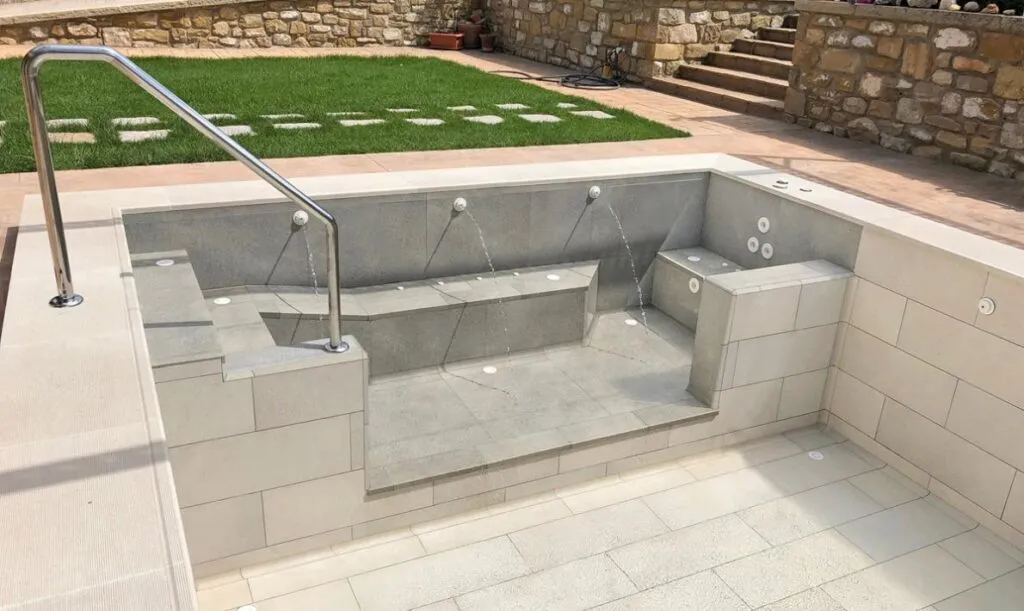
Although there are several manufacturers with similar systems, we are going to indicate the DryPool systems of Grupo Puma for the waterproofing of swimming pools, which we consider to be one of the best in the market. It is a system for the waterproofing and coating of swimming pools, composed of a watertight mortar, a cementitious adhesive specially formulated for its application in swimming pools and a grout. With this system we will ensure a watertight and durable finish for our pool.
What does the cementitious waterproofing system provide?
Safe waterproofing for:
- Avoid water leaks that force us to continually refill the pool and finally to lift the liner and re-waterproof.
- Correct maintenance of the pool thanks to good waterproofing and the use of materials suitable for continuous contact with water and the chemical agents used for its maintenance.
- Durable finishes with anti-mildew treatment and high performance adhesives.
- Compatible materials. Since it is a system, all materials are compatible with each other and maintain coherence in their adhesion and deformability properties.
Aspects to take into account
The placement of ceramic tiles in swimming pools must ensure resistance to permanent water pressure. The watertightness of the pool shell must be ensured before proceeding with the gluing of the pieces.
- The degree of absorption of the piece to be installed is a fundamental factor when choosing the adhesive.
- The pieces that we are going to place will be in permanent contact with water and with the chemical agents used for their maintenance.
- The ceramic pieces will withstand high pressures produced by the pool water, as well as negative pressures when the pool is emptied for maintenance.
- In some areas, contact with humidity and air will favor the development of fungi and bacteria on the joints, which should be avoided as much as possible by using a suitable grout material.

Within this type of systems, we can divide them into two:
-
Semi-flexible DryPool system.
- Waterproofing: Mordemdry SF Plus to ensure the watertightness of the pool.
- Coating: Pegoland Professional Porcelain Tile C2TE. Ideal for the installation of gresite and porcelain tiles in swimming pools.
- Grouting: Pegoland Professional Joint that is characterized by being water-repellent, minimizes efflorescence, resistant to fungi, algae, alkalis.
-
Flexible DryPool system.
- Waterproofing: Morcemdry F of great flexibility, resistance to positive and negative pressure to ensure the watertightness of the pool shell.
- Coating: Pegoland Professional Flex C2TES1. Deformable, ideal for laying both gresite and porcelain tiles.
- Grouting: Morcemcolor Epoxy, with high chemical and mechanical resistance, ideal for swimming pool joints with salt electrolysis or seawater treatment.
With this type of solution there are no constructive limits and it allows an endless number of options that with other systems would cost much more and would not have the elegant and safe final result obtained with a ceramic tile finish. At this point, we highlight the infinity of specific pieces for each constructive encounter, such as internal and external escocias, corner pieces, half-rounds… as well as the widest range of surface finishes, with imitation cement, stone, wood, slate, marble…

This type of solution is not only about the waterproofing of swimming pools, but an integral solution with all the constructive possibilities offered by the market. Due to our specialization in this type of finishes, it is undoubtedly the system that we recommend to our customers.
Among the manufacturers that we consider the best in this type of products we find Cerámica Mayor y Rosa Greswith whom we have been working for many years and know their entire catalog in depth.
Here you can find a few decorative ideas for creating charming small pools that can surely help you as well.
Depending on the type of water we have in the pool, it is very important the grouting of the pieces placed, whether ceramic tile or gresite, since it is the mortar that will be in continuous contact with water and with the chemical agents for the disinfection of the pool water, and therefore, the one that will suffer more deterioration over time.
Rubber swimming pool waterproofing system
Another more economical option is to replace the ceramic or gresite finish with a waterproofing paint. This type of paint is specific to water-based rubber. They are very resistant to fresh water, salt water and pool cleaning chemicals.
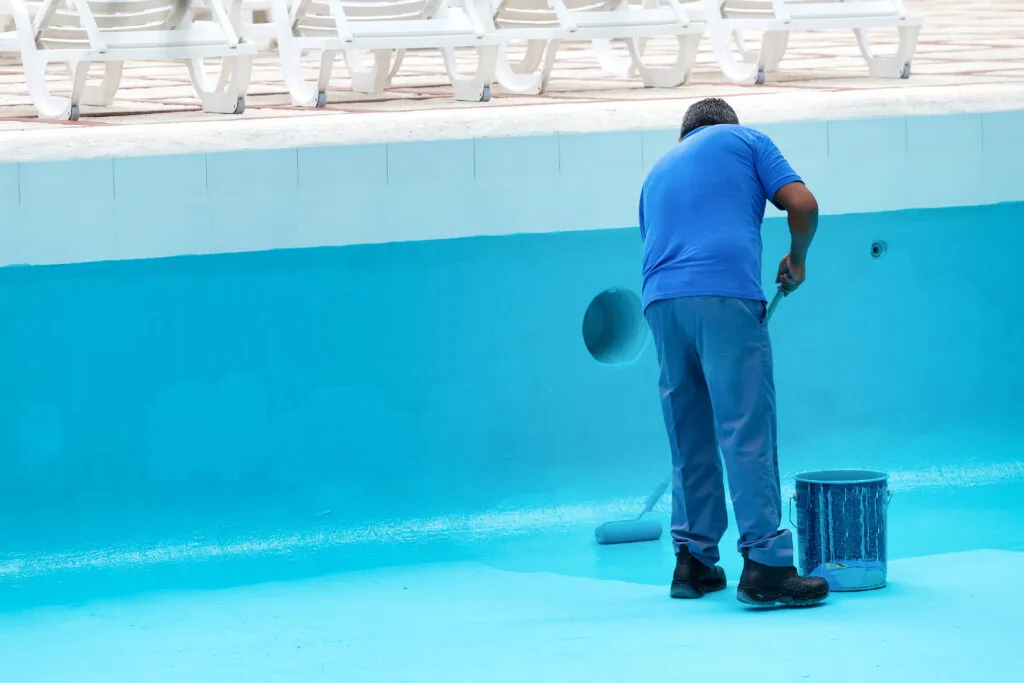
It can be applied both indoors and outdoors, for application on concrete and cement pool walls and floors, on new or previously painted surfaces.
The application can be made by brush, roller, spray gun or airless spray gun, after shaking the product and dilution, always following the normal practice of a good painting.
Swimming pool waterproofing system with geotextile membrane
The uses of the waterproofing sheets are very varied thanks to their core composition of a waterproof membrane constructed with layers of plastic film (EVAC) and non-woven fleece of polyester fibers together with polypropylene on each side.
We must emphasize that it is the most advantageous waterproofing solution when it comes to waterproofing renovation, since the waterproofing membrane can be installed over the existing pavement, placing the new ceramic tile over the membrane with a thin layer of tile adhesive cement.
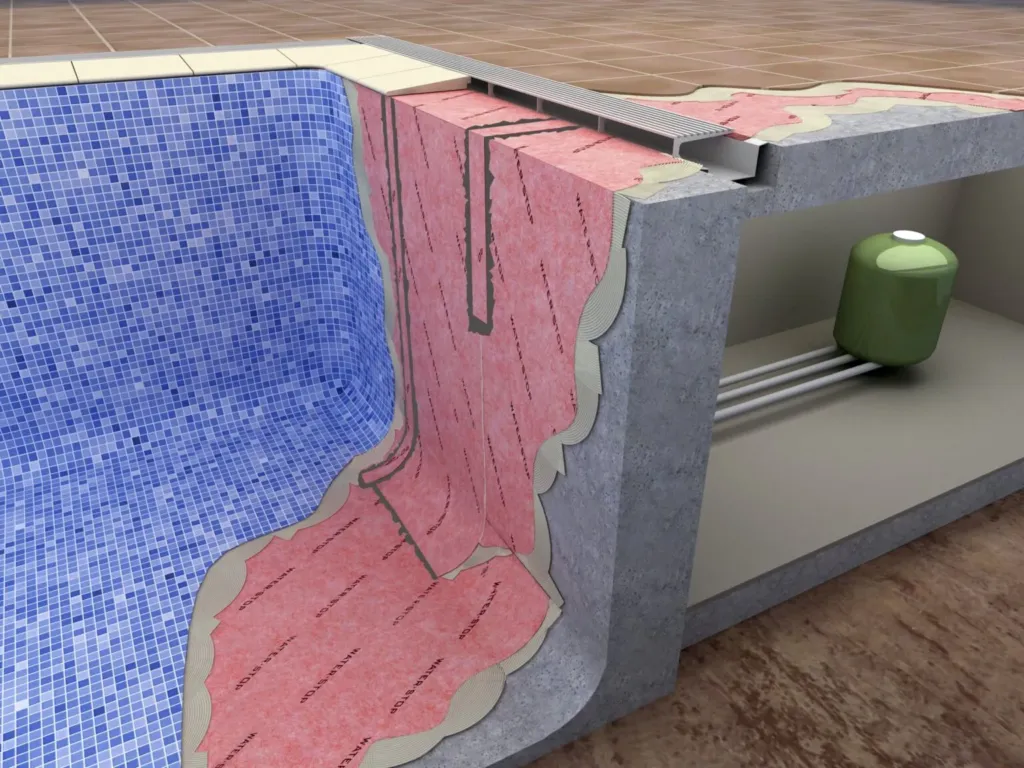
This type of membrane bridges small cracks, absorbs stresses at the junction between the liner and the substrate and reduces pathologies such as peeling and carbonation, thus helping to ensure the integrity of the pools. One of its main advantages over the competition would be the ease of installation (since only one person can take care of it) and the durability of the waterproofing. It should also be noted that pools can be waterproofed over old gresite.
Swimming pool leaks are usually the most common cause for considering waterproofing a swimming pool, as they are very difficult to find their origin and to repair.
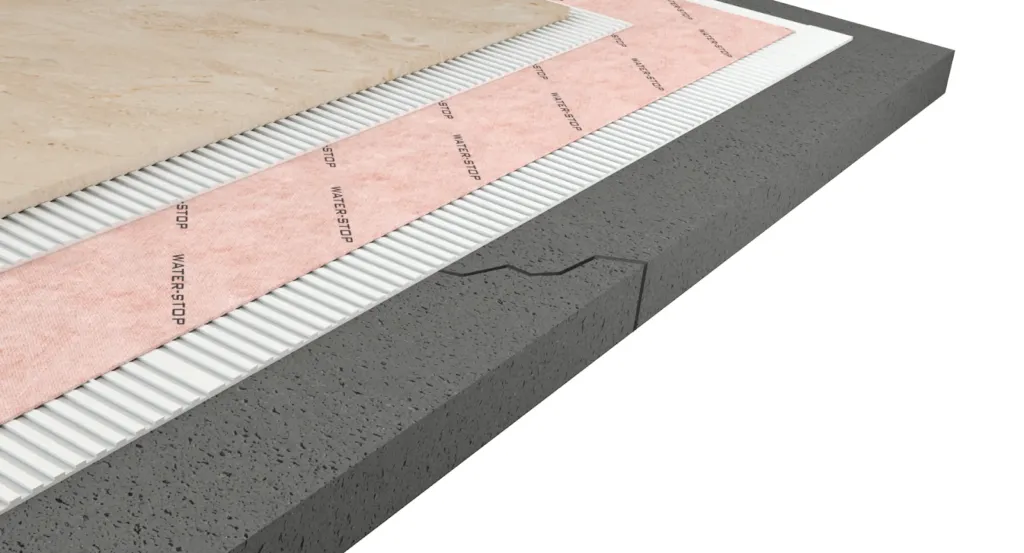
One of the most important points to evaluate is that for years it has been shown that concrete pools suffer from cracks and micro-cracks due to the aging of the structure, erosion or small movements of the ground. Most of these small cracks are not a problem for the structure, but they do have a great influence on the watertightness and waterproofing of the pool.
Another of the main problems of watertightness in swimming pools occurs between the main structure and the main accessories such as the skimmer, pipes, spotlights, nozzles or drains. This happens because the joints between them are not watertight or are made with waterproofing materials with a short useful life.

We recommend reading more in depth the following link where we indicate step by step the installation of this sheet for the waterproofing of swimming pools:
Swimming pool waterproofing system with polymeric membrane
Polymeric membrane systems offer high performance, adapt to any type of pool, do not require construction work, have exceptional chemical-physical characteristics, are usually reinforced, with multi-layers that ensure protection, elasticity, waterproofing and hardly require maintenance throughout their useful life, although they are particularly sensitive in their installation, due to the amount of overlaps they require.
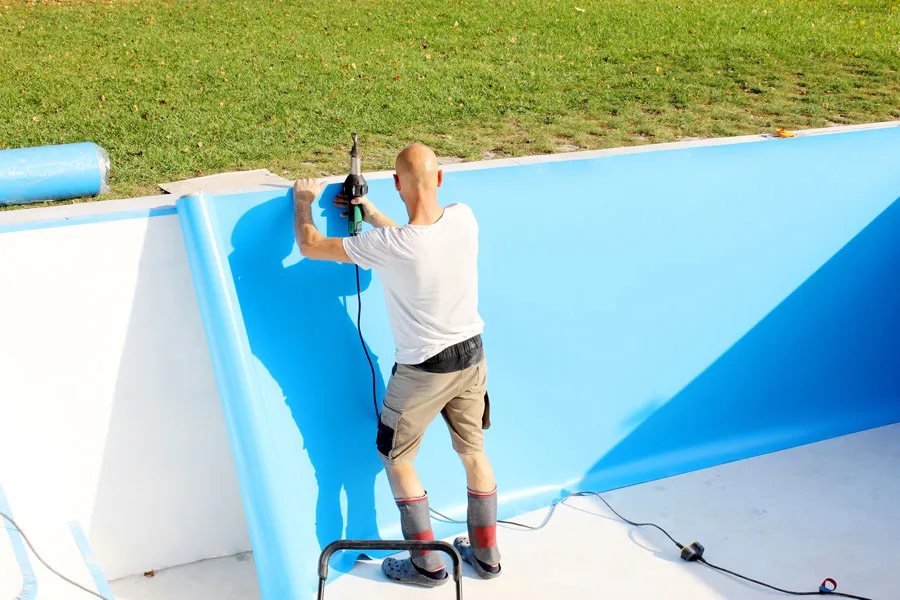
In many cases, in this type of installations it is necessary to take into account the waterproofing on the outside of the pool, to avoid the risk of wet bubbles from the outside to the inside, so a previous preventive treatment is always recommended to reduce this possibility.
There are more and more different designs on the market and it is an option to consider, especially for pool renovation, as it is a fast and safe process if installed correctly.
Generic products for waterproofing swimming pools
In addition to the indicated systems, which are composed each one of a series of products that form the final system, a series of products that help with the waterproofing of swimming pools once we already have the system and even so, we have some water leakage.
We find specially formulated chemical products that seal leaks or water leaks in swimming pools and can be applied regardless of their manufacture, whether concrete, chlorine paint, rubber, fiberglass, liner and are compatible with the materials used for cleaning the pool, such as PVC, ABS, copper, steel. These products do not deteriorate the interior of the pools and act in 24-48 hours.
In this link to our store you can see this type of product: View product
Here you can see the manufacturer’s video explaining the application process:

